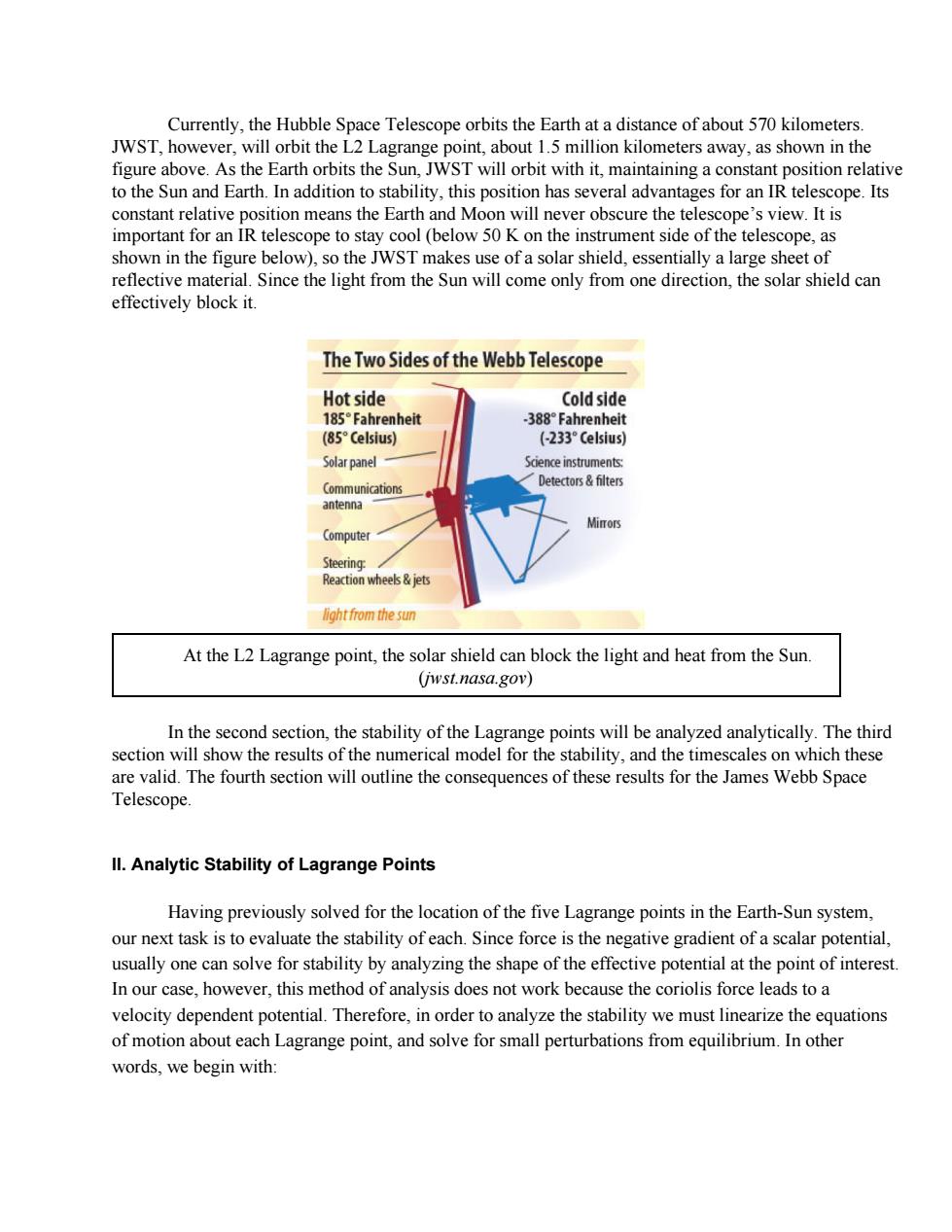正在加载图片...

Currently,the Hubble Space Telescope orbits the Earth at a distance of about 570 kilometers. JWST,however,will orbit the L2 Lagrange point,about 1.5 million kilometers away,as shown in the figure above.As the Earth orbits the Sun,JWST will orbit with it,maintaining a constant position relative to the Sun and Earth.In addition to stability,this position has several advantages for an IR telescope.Its constant relative position means the Earth and Moon will never obscure the telescope's view.It is important for an IR telescope to stay cool(below 50 K on the instrument side of the telescope,as shown in the figure below),so the JWST makes use of a solar shield,essentially a large sheet of reflective material.Since the light from the Sun will come only from one direction,the solar shield can effectively block it. The Two Sides of the Webb Telescope Hot side Cold side 185Fahrenheit 388°Fahrenheit (85°Celsius) (-233°Celsius) Solar panel Science instruments: Communications Detectors filters antenna Mimrors Computer Steering: Reaction wheels&jets light from the sun At the L2 Lagrange point,the solar shield can block the light and heat from the Sun. (jwst.nasa.gov) In the second section,the stability of the Lagrange points will be analyzed analytically.The third section will show the results of the numerical model for the stability,and the timescales on which these are valid.The fourth section will outline the consequences of these results for the James Webb Space Telescope. Il.Analytic Stability of Lagrange Points Having previously solved for the location of the five Lagrange points in the Earth-Sun system, our next task is to evaluate the stability of each.Since force is the negative gradient of a scalar potential, usually one can solve for stability by analyzing the shape of the effective potential at the point of interest. In our case,however,this method of analysis does not work because the coriolis force leads to a velocity dependent potential.Therefore,in order to analyze the stability we must linearize the equations of motion about each Lagrange point,and solve for small perturbations from equilibrium.In other words,we begin with:Currently, the Hubble Space Telescope orbits the Earth at a distance of about 570 kilometers. JWST, however, will orbit the L2 Lagrange point, about 1.5 million kilometers away, as shown in the figure above. As the Earth orbits the Sun, JWST will orbit with it, maintaining a constant position relative to the Sun and Earth. In addition to stability, this position has several advantages for an IR telescope. Its constant relative position means the Earth and Moon will never obscure the telescope’s view. It is important for an IR telescope to stay cool (below 50 K on the instrument side of the telescope, as shown in the figure below), so the JWST makes use of a solar shield, essentially a large sheet of reflective material. Since the light from the Sun will come only from one direction, the solar shield can effectively block it. At the L2 Lagrange point, the solar shield can block the light and heat from the Sun. (jwst.nasa.gov) In the second section, the stability of the Lagrange points will be analyzed analytically. The third section will show the results of the numerical model for the stability, and the timescales on which these are valid. The fourth section will outline the consequences of these results for the James Webb Space Telescope. II. Analytic Stability of Lagrange Points Having previously solved for the location of the five Lagrange points in the EarthSun system, our next task is to evaluate the stability of each. Since force is the negative gradient of a scalar potential, usually one can solve for stability by analyzing the shape of the effective potential at the point of interest. In our case, however, this method of analysis does not work because the coriolis force leads to a velocity dependent potential. Therefore, in order to analyze the stability we must linearize the equations of motion about each Lagrange point, and solve for small perturbations from equilibrium. In other words, we begin with: